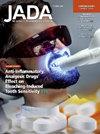Bactericidal efficacy of electrochemically activated solutions for dental unit waterlines
IF 3.5
2区 医学
Q1 DENTISTRY, ORAL SURGERY & MEDICINE
引用次数: 0
Abstract
Background
Biofilm formed on the interior surfaces of dental unit waterline (DUWL) tubing serves as a reservoir for planktonic microorganisms. The authors aimed to investigate the bactericidal efficacy of neutralized electrochemically activated solution (ECAS) for the water quality of DUWLs.
Methods
Twelve dental units were divided into group A (30 waterlines) and group B (6 waterlines) to be treated with the neutralized ECAS (ie, concentrated ECAS solution for shock treatment and diluted ECAS for daily maintenance, generated via the DW-8 countertop device [Dentaqua]) with different regimens. Three dental units (9 waterlines) were selected as a control group without treatment. Water samples were collected and then cultured to determine heterotrophic bacterial counts. Mann-Whitney U test and generalized estimating equations were used to determine the difference between groups. Tubing samples were evaluated by means of scanning electron microscopic analysis to assess the biofilm.
Results
The treatment was effective in diminishing the planktonic bacteria to meet the Centers for Disease Control and Prevention standards and inhibiting biofilm regrowth. Compared with the control group, the biofilm in DUWLs was partially removed in group A and group B at the end of treatment.
Conclusions
The neutralized ECAS is highly effective in eliminating the planktonic bacteria in DUWLs and is able to partially remove the established biofilm in DUWLs.
Practical Implications
The neutralized ECAS is a reasonable selection for biofilm prevention and inhibition in DUWLs.
电化学活化溶液对牙科设备水线的杀菌效果
背景在牙单元水线(DUWL)管的内表面形成的生物膜是浮游微生物的储存库。研究了中和电化学活化溶液(ECAS)对duwl水质的杀菌效果。方法将12个牙单元分为A组(30条水线)和B组(6条水线),采用不同方案的中和ECAS(即通过DW-8台面装置[Dentaqua]产生的ECAS浓缩液用于休克治疗,稀释ECAS用于日常维护)处理。选择3个牙单元(9个水线)作为对照组,不进行治疗。采集水样进行培养,测定异养细菌数量。采用Mann-Whitney U检验和广义估计方程确定组间差异。采用扫描电镜分析方法对管材样品进行生物膜评价。结果该处理能有效减少浮游细菌,达到疾病预防控制中心标准,抑制生物膜再生。与对照组相比,A组和B组在处理结束时duwl生物膜部分被去除。结论中和后的ECAS对DUWLs中的浮游细菌有较好的去除效果,并能部分去除DUWLs中已形成的生物膜。实际意义中和的ECAS是预防和抑制duwl生物膜的合理选择。
本文章由计算机程序翻译,如有差异,请以英文原文为准。
求助全文
约1分钟内获得全文
求助全文
来源期刊

Journal of the American Dental Association
医学-牙科与口腔外科
CiteScore
5.30
自引率
10.30%
发文量
221
审稿时长
34 days
期刊介绍:
There is not a single source or solution to help dentists in their quest for lifelong learning, improving dental practice, and dental well-being. JADA+, along with The Journal of the American Dental Association, is striving to do just that, bringing together practical content covering dentistry topics and procedures to help dentists—both general dentists and specialists—provide better patient care and improve oral health and well-being. This is a work in progress; as we add more content, covering more topics of interest, it will continue to expand, becoming an ever-more essential source of oral health knowledge.
 求助内容:
求助内容: 应助结果提醒方式:
应助结果提醒方式:


